
How Hanchic Adds an Edge to Korean Tradition, As Seen Through Five Dishes
Kyungbin Min excels at experimentation, so the curveball of the pandemic sent him into a spiral — a positive one that led to innovation after innovation. At his restaurant Hanchic, which he opened with Kevin Son and Dustin Lee in September 2020, he has been creating novel fusion dishes at lightning speed.
But Hanchic wasn’t always meant to be his star turn. In early 2020, Min co-founded a brand called Palate with Kevin Son, aging steaks and selling them via Instagram. He also co-launched a meal prep chicken concept called Chi Protein, and a fried chicken sandwich pop-up called Chimmelier.
“The plan with Hanchic originally was to make it a ghost kitchen, but because of how different the concept was, it started getting a lot of attention,” Min says. “So we invested everything into the restaurant, because we were furloughed and didn’t know if we were going to be able to get our jobs back again.”
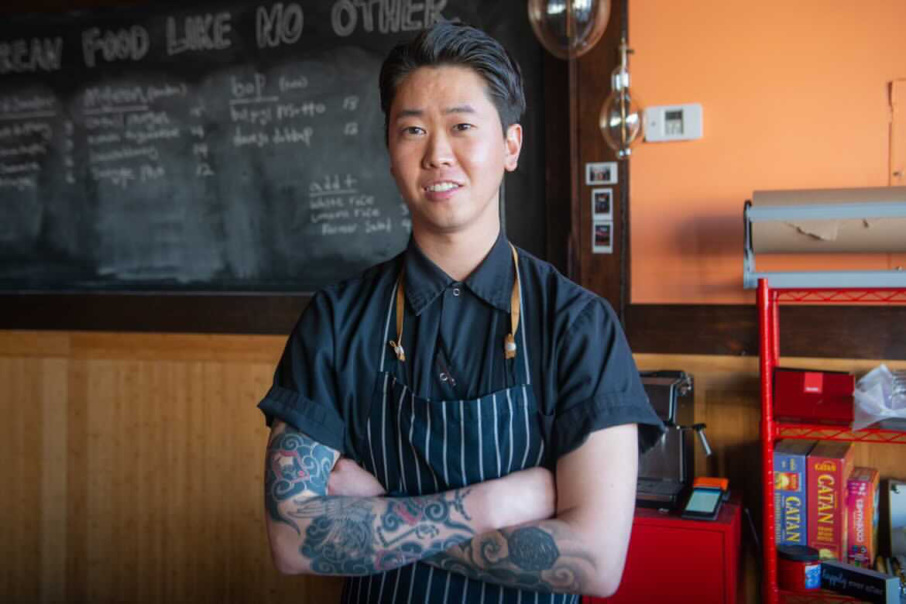
Born in Korea, Min emigrated to the U.S. as a child and grew up in the South Bay. Knowing he always wanted to be a chef, he attended culinary school at the now-shuttered Le Cordon Bleu in Pasadena, and landed at top spots like Kali in Hollywood, and Little Sister, the latter of which he was executive sous chef for seven years. He now lives a mere mile from Hanchic, which is fortunate because his work is now all-encompassing.
“Living in Koreatown with all these mom-and-pop shops that are number one at this and that, I don’t want to compete with tradition,” Min says. “I wanted to do something different — but when you taste it, it’s definitely Korean. In L.A., you have to be current.”
If that meant serving things like ragu tteokboki — deep-fried rice cakes coated in ragu rather than a more classic Korean spicy sauce — or a mashup of bouillabaisse and jjambbong, it worked, even if Min and his staff were serving these in the parking lot, to accommodate both pandemic rules and an unfinished buildout. More than that: He was building a menu in a restaurant that wasn’t built to be a restaurant. The kitchen had only two burners and one wok (no oven and no fryers). That, along with his penchant for marrying Korean ingredients with French or Italian techniques, left a lot to innovation.
Now that the dining room is open, Min says he’s excited to offer his spins on tradition to a wider audience.
“We have to keep moving forward and coming up with new concepts, and really execute little details, like how we’re going to showcase and present our dishes,” adds the chef. “We just have to keep moving forward. Hopefully we’ll eventually get somewhere.”
Here’s Hanchic, as seen through Min’s own words and five of the restaurant’s most popular dishes.
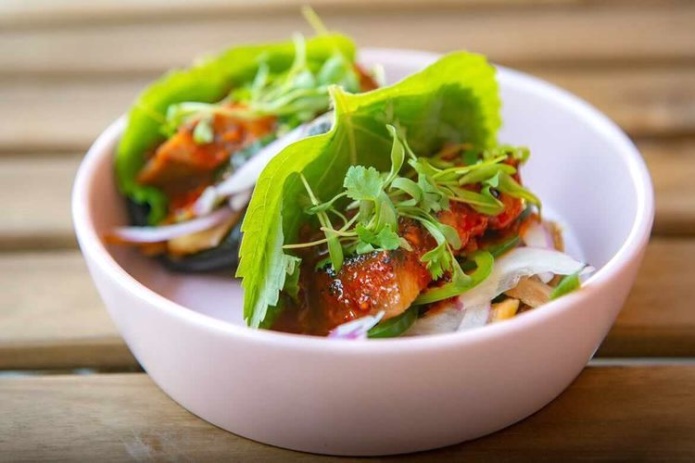
Spicy Pork Hobbang/ 통삼겹 호빵
“This dish is a love-hate for me because my stupid a– decided to do it all in-house, so I work until 3 a.m. making bao buns. I understand why people don’t do the buns in-house. I’m going to keep doing it, because as much as I hate it, if I give the recipe to someone else, they’re not going to do it the same and the love is not going to be there.
“I love hobbang mainly for the texture of it, because it’s so fluffy. All these breads are something we grew up with, having this very ‘It takes me back to I remember that time.’ I wanted to represent the barbecue that Koreans have at home, like samgyupsal with kkaennip (perilla leaves) and ssamjang, but I wanted to represent it in a way where non-Koreans are more able to relate to it, and the next thing I thought about how everyone knows what a bao bun is. I thought, let’s do a whole ssam in one bite.
“We use a charcoal bao bun, but the dough is higher in fat content, like a traditional hobbang dough bun, not like a bao bun. Inside go the kkaennip, pork belly, ssamjang, jalapeño, onions. We sous-vide the pork belly for 24 hours so it gets to this really melt-in-your-mouth point, and you get this gush of fat-rich meatiness. The ssamjang is sort of traditional, but when you eat it it creates different chunks, with bites of garlic, bites of jalapeño, a little bit of kick and spice.
“From the feedback I get, there are a lot of places that sell bao buns, but a lot of people who have this dish say it’s different, which is what our restaurant is about. It’s fluffy and light, but so many different components go into one bao bun.”
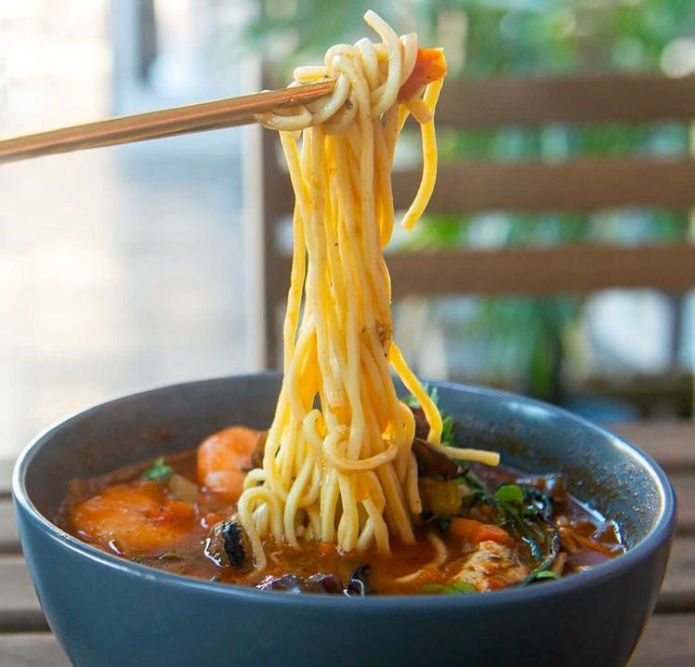
Bouillabbong/ 부야베스 짬뽕
“This fusion play between bouillabaisse and jjambbong (spicy seafood noodle soup) is one of our most-ordered dishes. It took me a long time to get down because I never really worked in a Korean restaurant, and I’m learning more Korean food as I go and the way I feel like it should be represented.
“Jjambbong is already a fusion of Korean and Chinese, but when I broke it down to flavor profiles, it made sense to try it with the bouillabaisse, a tomato and seafood stew that I learned how to make in culinary school but wasn’t too crazy about. I needed that burned oil flavor for jjambbong, so I tried flambéing seafood and adding it in, but that wasn’t as strong. So I tried making charcoal oil. You take charcoal or bincho wood, burn it until it’s embery and drop it in oil for a smoky oil flavor, then use it to flambé the seafood and now it has that jjambbong ‘bul mat’ (fire taste).
“It’s a spicy, seafoody, smoky, umami flavor — I always try to explain that this is a triple flavor. I ended up adding chrysanthemum leaves for more of a Korean flavor profile. You get that spicy, hearty, very refreshing ‘Aah!’ I love that feeling of a hot soup.”
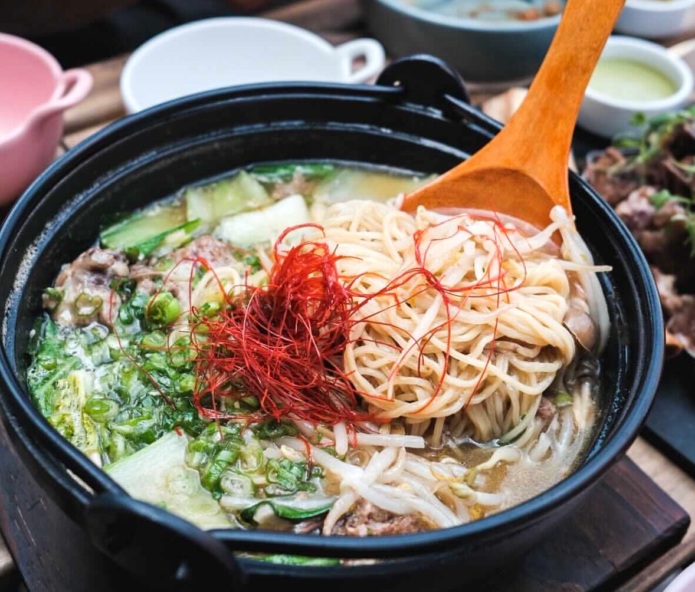
Oxtail Ramyeon/ 소꼬리 곰탕면
“This is a 96-hour bone broth made like a traditional seolleontang (ox-bone soup). I have fond memories of seolleontang. My mom would always be boiling a fantastic pot of seolleongtang because she knew I liked it, so there was always a pot on the stove, and I would just add a little bit of rice and kimchi to it. She had to teach me how to blanch the bones, wash out impurities, and then start making the broth. When you do it right, you get that milky white color.
“Almost every Sunday after church, we would get seolleontang. Koreans love to drink, so you eat seolleongtang the next day and feel awake, and come back to life. It’s one of the soups I really love that doesn’t make me feel too sluggish and hits the spot all the time.
“I made this more ramen-style because I love ramen and soup, but at the same time, I always feel a little gross after eating ramen. I love it, but I’m not trying to go to sleep right away. But with the sagol (bone broth), it’s hearty, beefy, and clean. We add ramen egg noodles, for more of a bite than the usual seolleongtang dangmyeon noodles. Then the fermented chile paste oil changes the whole complexity of it and gives it that super rich umami with a little spice in it. That’s the playful part of it: you can always sort of make it your own way since you get to mix it up.”
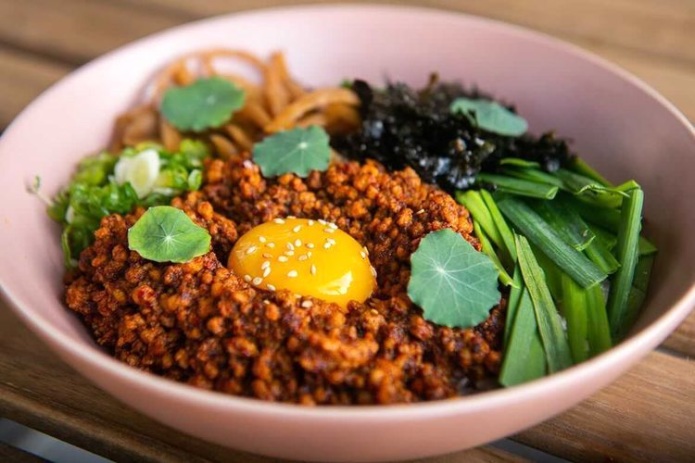
Dweji Dupbap/ 감칠맛 돼지덮밥
“This has been one of our main sellers because it’s easily portable, we were takeout-only when we opened, and everything had to hold for at least an hour or more. There was a lot of trial and error with all the dishes, to make it the same quality when it gets to the person.
“It has umami rice on the bottom, which has garlic butter and dashi. On top of that, you put gim (seaweed), sesame seed and sesame oil, for that taste like when mom would make you kimbap to snack on and eat. On top of the bed of umami rice, there are buchu (Korean chives), scallions, seaweed, jjangachi (Korean pickles), ground pork with dahdaegi, a fermented chile paste that, depending on how you use it, changes the flavor of food drastically. Then I thought, it needs more yachae (vegetables), so I added scallions and buchu (Korean chives), plus a little bit of the vinegar aspect with the jjangachi that balanced whole dish out. And egg yolk to add creaminess.
“The main thing here is balance. We wanted people to taste the dahdaegi because a lot of people might not know.”
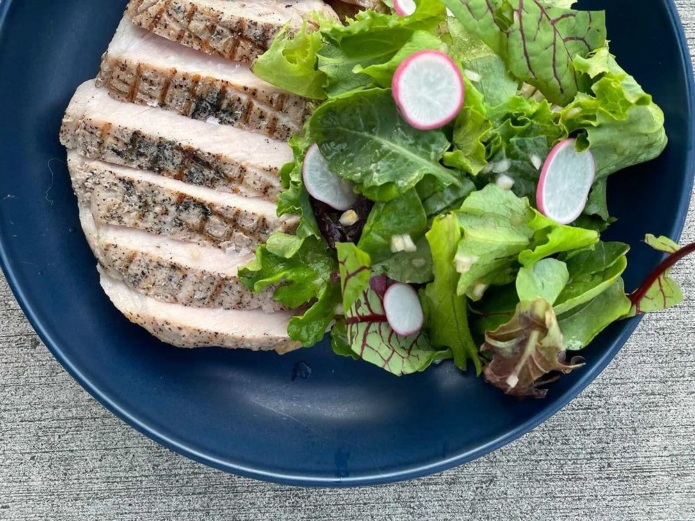
Aged Pork Loin and Doenjang Hummus/ 숙성 돼지로인
“I was getting a little too creative because I needed something bougie, but we don’t want to price our menu too high because my goal is to showcase different flavors of Korean food, from higher- and middle- to lower-end. Pork isn’t too expensive, so I use a cheaper cut but add some finesse and technique. I thought, why not age pork and test it out? We aged the pork loin 28 days, and found out the pork loin is really tender after aging it — super soft. On top of that, we’re sous-viding it, which is very protective of damage. We’re aging it only 28 days, so we don’t have that much of a loss, so we don’t need to charge super high.
“The doenjang hummus is key. When I was coming up with the idea, I broke it down to: I need pork and beans, and hummus is chickpeas, a type of bean, and doenjang uses beans. So I was like, why not try a traditional hummus with doenjang and cheonggukjang (a chunky traditional Korean fermented soybean ingredient). I had to play around with the balance, making sure it was not too cheonggukjang-y to put off people.
“It’s not hummus, but it’s something you recognize from somewhere, and you can’t put a finger on it. The hummus is on the bottom, we spread the pork loin on one side of the plate, put another ball of salad on the side that has the maesil (green plum) vinaigrette. When you eat it all together, it tastes like you’re eating ssam.
“Especially with aged meats, I wanted people to try it out — you can really tell the difference. I hate when people can’t afford things, and I know my food can be good but affordable for all.”
Dakota Kim is a writer, editor and recovering restaurant owner living in Los Angeles. Her stories have appeared in the Los Angeles Times, New York Times, Food & Wine, Travel + Leisure, Civil Eats, Food52, and many other publications. Follow her on Twitter. Follow Resy, too.
















